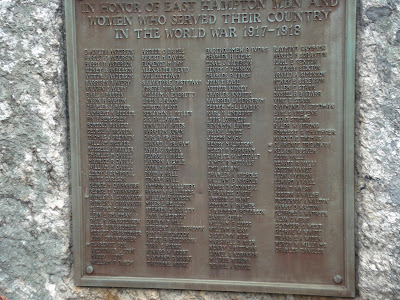The Village Center has witnessed quite a transformation throughout the past hundred years. Until the 1970s, the intersection of Main Street, Barton Hill, and Summit Street encompassed our business center that has since migrated to Rt. 66. Surrounding this Village Center retail district were mills and plants – Summit Thread, Starr Manufacturing, Bevin Bros., N. N. Hills Brass, the Gong Bell Mfg. Co. among others, many of which were the remnants of the fabled bell industry for which East Hampton was so famous.
In the mid 1940s two real estate transactions of significance occurred. In May 1946 the Carrier Block was sold by Mrs. Earl C. Hitchcock, Sr. (who had recently purchased it from the Estate of Mayo Purple, former President of the Gong Bell Mfg. Co.) to Spencer Jewell for $15,000. This building has seen both a fire and an explosion in recent years has been rebuilt and still remains as the 3 story building in the Center.

Mr. Mayo Purple in front of Carrier Block
In the 1940s it housed apartments, as it does today and 3 businesses – a First National Grocery Store, the Chatham Store - a hardware store operated by Howard Selden and the Chatham Pharmacy operated by the Hitchcock family.

The Carrier Block - First National, Selden's Hardware and Hitchcock Pharmacy and the O'Connell Block
Mr. Jewell constructed a plumbing shop that he occupied in an old section of the building in the rear on Barton Hill.

In January 1945, Stanley G. Warzecha purchased the O’Connell block and Purple garage in the Center for approx. $25,000 in what was then the largest real estate transaction in our history. The garage and two-story block were adjoining properties on the north corner of Main St. and Barton Hill. The garage had been a bus depot. Mr. Warzecha built a filling station and operated Steve’s Auto Sales – a Dodge and Plymouth dealership. The garage functioned as the Town’s Public Works facility from the 1960s to early 80s and today it is the parking lot for the Joseph N. Goff House.





 He exemplified the Greek ideal of an athlete in competition – using one’s skills and ability in pursuit of excellence without doing personal harm or injury to his fellow competitor. On and off the field he is and was a gentleman. A fierce competitor, Bill achieved success not at the expense of others, but through his own skill, determination and hard work as a team player.
He exemplified the Greek ideal of an athlete in competition – using one’s skills and ability in pursuit of excellence without doing personal harm or injury to his fellow competitor. On and off the field he is and was a gentleman. A fierce competitor, Bill achieved success not at the expense of others, but through his own skill, determination and hard work as a team player. The paradox really explains the man. He is a sportsman whose accomplishments resulted from fair play, fierce competition and a never say die attitude. His conduct and these attributes are a world apart from dirty play and poor character.
The paradox really explains the man. He is a sportsman whose accomplishments resulted from fair play, fierce competition and a never say die attitude. His conduct and these attributes are a world apart from dirty play and poor character.
